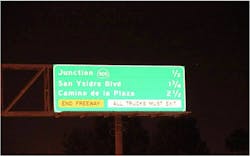Caltrans tests reflective sheeting for guide-sign visibility and cost savings
The California Department of Transportation (Caltrans) is on a mission to improve mobility across the state. Caltrans has goals around safety and stewardship including preservation and enhancement of California’s resources and assets. Those goals led Caltrans District 11 to initiate a pilot project to find a reflective sheeting that would meet the visual requirements of California drivers and eliminate future needs for electrical-sign lighting.
The pilot project was organized to visually test guide signs made with ASTM Type XI sheeting without external lighting. Caltrans selected I-805/S.R. 905 located near the international border with Mexico for this project. The west segment of S.R. 905 was recently extended by about six miles (from I-805 to the Otay Mesa Border Port of Entry), making it a perfect project to pilot Type XI sheeting. The test was conducted using 3M Diamond Grade DG³ Type XI reflective sheeting on 11 guide signs.
Caltrans engineers viewed Type XI test signs utilizing only vehicle headlights and the results were visually impressive. Signs were clear and visible as if the overhead lights were still on. Based on the pilot’s success, Caltrans District 11 conducted further research on sign life-cycle costs comparing Type IV sheeting to Type XI, reflectivity over time and manufacturers’ warranties. They also networked with other DOTs nationwide and compared guide-sign practices.
“We have started using Type XI sheeting on several other projects in our district including a design-build project with direct access ramps and HOV lanes on I-805, the S.R. 76/I-15 revise interchange project, and two other HOV lane projects in the South Bay,” said Camille Abou-Fadel, Caltrans District 11 Traffic Design Signing & Striping Branch Chief. “Now more than ever, we need to pay additional attention to retroreflectivity values as the latest MUTCD has new requirements for maintaining minimum retroreflectivity levels on all our signs.”
In addition to reduced electricity costs, Caltrans officials anticipate other savings and safety benefits including reduced maintenance costs, increased worker safety, better sign life-cycle costs and reduced greenhouse gases.
